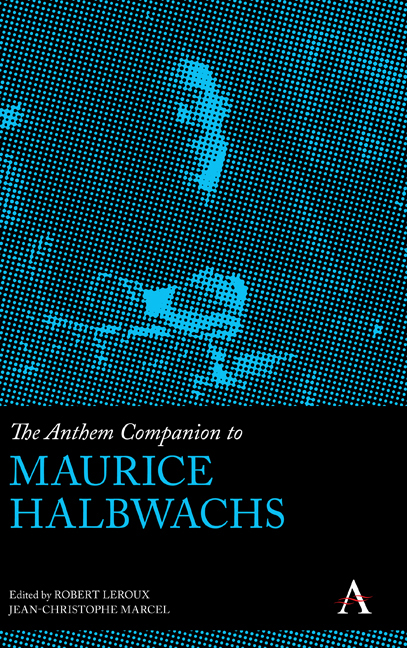Book contents
- Frontmatter
- Contents
- Introduction
- Chapter 1 A Theorist of Collective Memory
- Chapter 2 Halbwachs and the Durkheimian Perspective on History
- Chapter 3 Maurice Halbwachs, Sociologist of Memory: His Reception in Italy and the Development of the Sociology of Memory
- Chapter 4 Population as the Body of Society
- Chapter 5 Urban Morphology and Social Morphology: Marcel Roncayolo and the Work of Maurice Halbwachs
- Chapter 6 Halbwachs’s Leibniz and Halbwachs’s Sociology
- Chapter 7 Halbwachs on Quetelet and the Use of Statistics in Sociology
- Chapter 8 Maurice Halbwachs and the Sociology of Consumption and Social Classes
- Chapter 9 From Criticism of Moral to the Probalistic Test
- Chapter 10 The Age Criterion: Between Sociology and Biology
- Chapter 11 Speculation: Order or Disorder?
- List of Contributors
- Index
Chapter 5 - Urban Morphology and Social Morphology: Marcel Roncayolo and the Work of Maurice Halbwachs
Published online by Cambridge University Press: 23 February 2022
- Frontmatter
- Contents
- Introduction
- Chapter 1 A Theorist of Collective Memory
- Chapter 2 Halbwachs and the Durkheimian Perspective on History
- Chapter 3 Maurice Halbwachs, Sociologist of Memory: His Reception in Italy and the Development of the Sociology of Memory
- Chapter 4 Population as the Body of Society
- Chapter 5 Urban Morphology and Social Morphology: Marcel Roncayolo and the Work of Maurice Halbwachs
- Chapter 6 Halbwachs’s Leibniz and Halbwachs’s Sociology
- Chapter 7 Halbwachs on Quetelet and the Use of Statistics in Sociology
- Chapter 8 Maurice Halbwachs and the Sociology of Consumption and Social Classes
- Chapter 9 From Criticism of Moral to the Probalistic Test
- Chapter 10 The Age Criterion: Between Sociology and Biology
- Chapter 11 Speculation: Order or Disorder?
- List of Contributors
- Index
Summary
Maurice Halbwachs occupies a prominent place in the work of the recently deceased geographer Marcel Roncayolo (1926– 2018). In order to verify it, it is possible, as a first step, to rely on two “reference works,” which are among the main works by Marcel Roncayolo: La Ville et ses territoires (1990) and L’Abécédaire (2011).
Although very different in their nature and in their format, they are very convergent in their content, in the references they mobilize, and in the facts of urban history which are reported there. Also very different in their way of writing, their composition and their goals, written at times quite distant during the author's scientific career, they both have, however, the value of synthetic texts. They allow, if not to cover all of his scientific reflection, at least to identify the favorite themes.
Written in a classic way, La Ville et ses territoires is entirely a kind of essay. His different chapters browse a set of classic issues in urban studies: beginnings of the city; urban population, urban functions, and cultures; morphology and city map; social and functional divisions of urban space; political dimension of the city; urban representations and ideologies. For the most part (first eight chapters), this book is a French version of two series of articles previously published in Italian: “Città,” in Romano Ruggiero (dir.), Enciclopedia Einaudi, III. (1978), and La Città, stoia e problemi della dimensione urbana (1988).
L’Abécédaire comes from a totally different form. Transcription of a series of interviews with the philosopher Isabelle Chesneau, it seems, at first glance, like any work of this type, ruled in a certain arbitrary concerning the choice of themes chosen and the sequence of chapters and ideas, highly random and discontinuous because subject to the order of the letters of the alphabet. Although the author denies it, this is an authentic scientific work. At the beginning of the “Warning” intended for the reader (Roncayolo 2011, 6), he warned, with modesty, that he had refrained from delivering “[neither] a treaty, nor a current state of knowledge.”
- Type
- Chapter
- Information
- The Anthem Companion to Maurice Halbwachs , pp. 77 - 98Publisher: Anthem PressPrint publication year: 2021



